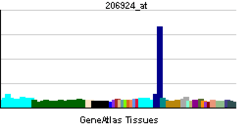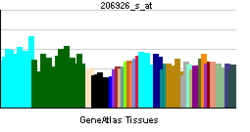Interleukin 11
| View/Edit Human | View/Edit Mouse |
Interleukin 11 (IL-11) is a protein that in humans is encoded by the IL11 gene.[3]
IL-11 is a multifunctional cytokine first isolated in 1990 from bone marrow-derived stromal cells. It is a key regulator of multiple events in hematopoiesis, most notably the stimulation of megakaryocyte maturation.[4] It is also known under the names adipogenesis inhibitory factor (AGIF)[5] and oprelvekin.
The human IL-11 gene, consisting of 5 exons and 4 introns, is located on chromosome 19,[3] and encodes a 23 kDa protein. IL-11 is a member of the IL-6-type cytokine family, distinguished based on their use of the common co-receptor gp130. Signal specificity is provided by the IL-11Rα subunit.
Downstream signalling
Signal transduction is initiated upon binding of IL-11 to IL-11Ralpha and gp130, facilitating the homodimerization of gp130 molecules. This permits gp130-associated Janus kinases (JAK) to become activated and phosphorylate intracellular tyrosine residues on gp130.[6]
Function
IL-11 has been demonstrated to improve platelet recovery after chemotherapy-induced thrombocytopenia, induce acute phase proteins, modulate antigen-antibody responses, participate in the regulation of bone cell proliferation and differentiation IL-11 causes bone-resorption. It stimulates the growth of certain lymphocytes and, in the murine model, stimulates an increase in the cortical thickness and strength of long bones. In addition to having lymphopoietic/hematopoietic and osteotrophic properties, it has functions in many other tissues, including the brain, gut, testis and bone.[7]
As a signaling molecule, interleukin 11 has a variety of functions associated with its receptor interleukin 11 receptor alpha; such functions include placentation and to some extent of decidualization.[8] IL11 has been expressed to have a role during implantation of the blastocyst in the endometrium of the uterus; as the blastocyst is imbedded within the endometrium, the extravillous trophoblasts will invade the maternal spiral arteries for stability and the transfer of essential life-sustaining elements via the maternal and fetal circulatory systems. This process is highly regulated due to detrimental consequences that can arise from aberrations of the placentation process: poor infiltration of the trophoblasts may result in preeclampsia while severely invasive trophoblasts may resolve in placenta accreta, increta or percreta; all defects which most likely would result in the early demise of the embryo and/or negative effects upon the mother.[8] IL11 has been shown to be present in the decidua and chorionic villi to regulate the extent in which the placenta implants itself; regulations to ensure the well-being of the mother but also the normal growth and survival of the fetus. A murine knockout model has been produced for this particular gene, with initial studies involving IL11 role in bone pathologies but have since progressed to fertility research; further research utilizes endometrial and gestational tissue from humans.[8][9]
Medical use
Interleukin 11 is manufactured using recombinant DNA technology and is marketed as a protein therapeutic called oprelvekin, for the prevention of severe thrombocytopenia in cancer patients.[10]
See also
References
- ↑ "Human PubMed Reference:".
- ↑ "Mouse PubMed Reference:".
- 1 2 McKinley D, Wu Q, Yang-Feng T, Yang YC (1992). "Genomic sequence and chromosomal location of human interleukin-11 gene (IL11)". Genomics. 13 (3): 814–9. doi:10.1016/0888-7543(92)90158-O. PMID 1386338.
- ↑ Paul SR, Bennett F, Calvetti JA, Kelleher K, Wood CR, O'Hara RM, Leary AC, Sibley B, Clark SC, Williams DA (1990). "Molecular cloning of a cDNA encoding interleukin 11, a stromal cell-derived lymphopoietic and hematopoietic cytokine". Proc. Natl. Acad. Sci. U.S.A. 87 (19): 7512–6. doi:10.1073/pnas.87.19.7512. PMC 54777
 . PMID 2145578.
. PMID 2145578. - ↑ Kawashima I, Ohsumi J, Mita-Honjo K, Shimoda-Takano K, Ishikawa H, Sakakibara S, Miyadai K, Takiguchi Y (1991). "Molecular cloning of cDNA encoding adipogenesis inhibitory factor and identity with interleukin-11". FEBS Lett. 283 (2): 199–202. doi:10.1016/0014-5793(91)80587-S. PMID 1828438.
- ↑ Heinrich PC, Behrmann I, Haan S, Hermanns HM, Müller-Newen G, Schaper F (August 2003). "Principles of interleukin (IL)-6-type cytokine signalling and its regulation". Biochem. J. 374 (Pt 1): 1–20. doi:10.1042/BJ20030407. PMC 1223585
 . PMID 12773095.
. PMID 12773095. - ↑ Sims NA, Jenkins BJ, Nakamura A, Quinn JM, Li R, Gillespie MT, Ernst M, Robb L, Martin TJ (July 2005). "Interleukin-11 receptor signaling is required for normal bone remodeling.". Journal of Bone and Mineral Research. 20 (7): 1093–102. doi:10.1359/JBMR.050209. PMID 15940362.
- 1 2 3 Paiva P, Salamonsen LA, Manuelpillai U, Walker C, Tapia A, Wallace EM, Dimitriadis E (November 2007). "Interleukin-11 promotes migration, but not proliferation, of human trophoblast cells, implying a role in placentation". Endocrinology. 148 (11): 5566–72. doi:10.1210/en.2007-0517. PMID 17702845.
- ↑ Chen HF, Lin CY, Chao KH, Wu MY, Yang YS, Ho HN (May 2002). "Defective production of interleukin-11 by decidua and chorionic villi in human anembryonic pregnancy". J. Clin. Endocrinol. Metab. 87 (5): 2320–8. doi:10.1210/jc.87.5.2320. PMID 11994383.
- ↑ Neumega
Further reading
- Yang YC, Yin T (1993). "Interleukin-11 and its receptor.". BioFactors. 4 (1): 15–21. PMID 1292471.
- Bhatia M, Davenport V, Cairo MS (2007). "The role of interleukin-11 to prevent chemotherapy-induced thrombocytopenia in patients with solid tumors, lymphoma, acute myeloid leukemia and bone marrow failure syndromes.". Leuk. Lymphoma. 48 (1): 9–15. doi:10.1080/10428190600909115. PMID 17325843.
- McKinley D, Wu Q, Yang-Feng T, Yang YC (1992). "Genomic sequence and chromosomal location of human interleukin-11 gene (IL11).". Genomics. 13 (3): 814–9. doi:10.1016/0888-7543(92)90158-O. PMID 1386338.
- Kawashima I, Ohsumi J, Mita-Honjo K, et al. (1991). "Molecular cloning of cDNA encoding adipogenesis inhibitory factor and identity with interleukin-11.". FEBS Lett. 283 (2): 199–202. doi:10.1016/0014-5793(91)80587-S. PMID 1828438.
- Paul SR, Bennett F, Calvetti JA, et al. (1990). "Molecular cloning of a cDNA encoding interleukin 11, a stromal cell-derived lymphopoietic and hematopoietic cytokine.". Proc. Natl. Acad. Sci. U.S.A. 87 (19): 7512–6. doi:10.1073/pnas.87.19.7512. PMC 54777
 . PMID 2145578.
. PMID 2145578. - Wang XY, Fuhrer DK, Marshall MS, Yang YC (1996). "Interleukin-11 induces complex formation of Grb2, Fyn, and JAK2 in 3T3L1 cells.". J. Biol. Chem. 270 (47): 27999–8002. doi:10.1074/jbc.270.47.27999. PMID 7499280.
- Chérel M, Sorel M, Lebeau B, et al. (1995). "Molecular cloning of two isoforms of a receptor for the human hematopoietic cytokine interleukin-11.". Blood. 86 (7): 2534–40. PMID 7670098.
- Yamaguchi M, Miki N, Ono M, et al. (1995). "Inhibition of growth hormone-releasing factor production in mouse placenta by cytokines using gp130 as a signal transducer.". Endocrinology. 136 (3): 1072–8. doi:10.1210/en.136.3.1072. PMID 7867561.
- Mehler MF, Rozental R, Dougherty M, et al. (1993). "Cytokine regulation of neuronal differentiation of hippocampal progenitor cells.". Nature. 362 (6415): 62–5. doi:10.1038/362062a0. PMID 8383296.
- Morris JC, Neben S, Bennett F, et al. (1996). "Molecular cloning and characterization of murine interleukin-11.". Exp. Hematol. 24 (12): 1369–76. PMID 8913282.
- Neddermann P, Graziani R, Ciliberto G, Paonessa G (1997). "Functional expression of soluble human interleukin-11 (IL-11) receptor alpha and stoichiometry of in vitro IL-11 receptor complexes with gp130.". J. Biol. Chem. 271 (48): 30986–91. doi:10.1074/jbc.271.48.30986. PMID 8940087.
- Barton VA, Hudson KR, Heath JK (1999). "Identification of three distinct receptor binding sites of murine interleukin-11.". J. Biol. Chem. 274 (9): 5755–61. doi:10.1074/jbc.274.9.5755. PMID 10026196.
- Tacken I, Dahmen H, Boisteau O, et al. (1999). "Definition of receptor binding sites on human interleukin-11 by molecular modeling-guided mutagenesis.". Eur. J. Biochem. 265 (2): 645–55. doi:10.1046/j.1432-1327.1999.00755.x. PMID 10504396.
- Mahboubi K, Biedermann BC, Carroll JM, Pober JS (2000). "IL-11 activates human endothelial cells to resist immune-mediated injury.". J. Immunol. 164 (7): 3837–46. doi:10.4049/jimmunol.164.7.3837. PMID 10725745.
- Barton VA, Hall MA, Hudson KR, Heath JK (2000). "Interleukin-11 signals through the formation of a hexameric receptor complex.". J. Biol. Chem. 275 (46): 36197–203. doi:10.1074/jbc.M004648200. PMID 10948192.
- Curti A, Tafuri A, Ricciardi MR, et al. (2002). "Interleukin-11 induces proliferation of human T-cells and its activity is associated with downregulation of p27(kip1).". Haematologica. 87 (4): 373–80. PMID 11940481.
- Van der Meeren A, Mouthon MA, Gaugler MH, et al. (2002). "Administration of recombinant human IL11 after supralethal radiation exposure promotes survival in mice: interactive effect with thrombopoietin". Radiat. Res. 157 (6): 642–9. doi:10.1667/0033-7587(2002)157[0642:AORHIA]2.0.CO;2. PMID 12005542.
- McCloy MP, Roberts IA, Howarth LJ, et al. (2002). "Interleukin-11 levels in healthy and thrombocytopenic neonates". Pediatr. Res. 51 (6): 756–60. doi:10.1203/00006450-200206000-00016. PMID 12032273.
- Bartz H, Büning-Pfaue F, Türkel O, Schauer U (2002). "Respiratory syncytial virus induces prostaglandin E2, IL-10 and IL-11 generation in antigen presenting cells". Clin. Exp. Immunol. 129 (3): 438–45. doi:10.1046/j.1365-2249.2002.01927.x. PMC 1906469
 . PMID 12197884.
. PMID 12197884.


